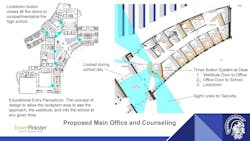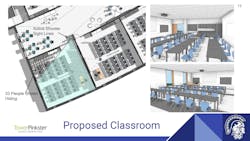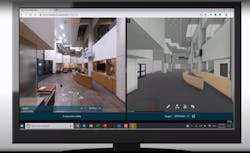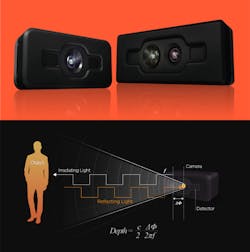This article originally appeared in the June 2020 issue of Security Business magazine. When sharing, don’t forget to mention @SecBusinessMag on Twitter and Security Business magazine on LinkedIn.
It was closing time for bars in the popular Oregon district of Dayton, Ohio, when a gunman shot 26 people in just 32 seconds before being fatally shot by an officer, who potentially saved hundreds of lives.
When it comes to an active shooter or active assailant event, time is critical. A fast response can mean hundreds of lives saved. The Department of Homeland Security’s Active Shooter: How to Respond educational booklet reports that “the average duration of active shooter incidents in institutions of higher education within the United States is 12.5 minutes. In contrast, the average response time of campus and local law enforcement from the beginning of the incident to the scene is 18 minutes.”
It is critical for security integrators to help quicken this response time, whether it happens on a higher-ed campus, a K-12 facility or even a corporate or retail facility. While law enforcement is the primary defense against these assailants, security integrators can bring multiple technology alternatives to the table to build a safer facility while enabling faster response times.
Site Design
During World War I, engineers dug zigzagging patterns through the earth to prevent enemy soldiers from shooting in a straight line down the length of the trench – leaving relative few exposed to gunfire or shrapnel. Schools need to take the same design mindset.
One recent example is Fruitport High School in western Michigan, which embarked on a controversial $48 million construction retrofit project in August 2019 to add curved hallways to reduce an assailant’s line of sight. In addition, to the hallway areas, architects from Michigan-based firm TowerPinkster designed classrooms to provide cover and egress, including an area in each one that cannot be seen from the hallway. Each classroom also includes lockdown on demand and shelter-in-place areas.
To prove the use of aggressive ingress, egress and shelter space architectural modifications will slow the attack, an assessment of the projected modifications will enable the security expert to virtually visit the modified facility at any time. One software provider, Visual Plan (http://visualplan.net) is bringing 3D technology to that process. Besides being easier and more cost-effective than traditional methods of measurement and facility mapping, the Visual Plan 360° capture software enables virtual collaboration, design, review, inspections and assessments, the company says on its website. It also allows various stakeholders to share, annotate and mark-up critical building information safely and remotely. In case of an emergency, the software also enables real-time collaboration with first responders.
Weapons Detection
To save precious response time for law enforcement to arrive and local School Resource Officers to act, a proactive threat detection and alert system that automatically detects guns in a real-time through a camera’s RTSP video feed is necessary.
Athena Security (http://athena-security.com) solves this issue by using artificial intelligence to virtually detect a weapon – whether a gun or knife – on a person instantly. Once a threat is detected, the hybrid cloud solution automatically communicates critical information in real time to mobile devices, law enforcement and monitoring service and initiates automatic lockdown.
For maximum reliability, feeds from entry and hallway cameras are directly analyzed by the AI weapons detection algorithm, so the school can prioritize the purchase of “actionable” technology in the event they do not spend time monitoring a video management solution.
Time of Flight Sensors and Facial Recognition
Creating reduced sight lines – such as with the Fruitport High School renovation – produces an unconventional video surveillance challenge that requires a greater number of image sensors at a lower cost. Time of Flight (ToF) sensors – which enable real-time 3D tracking by measuring the time it takes for a beam of light to be reflected back from a surface – could be the answer. The sensors support technologies such as facial recognition, object recognition and augmented reality.
Cameras like the Basler Blaze industrial 3D camera (www.baslerweb.com) operate on the pulsed ToF principle to recognize faces and weapons in three dimensions, and automating active assailant threat recognition.
At the 2020 CES show, the Meere Company demonstrated a range of ToF video surveillance “Cube Eye” cameras performing functions like short-range object recognition and facial recognition. About the size of a package of gum, the cameras can support fall detection, gesture control, augmented and virtual reality, people counting, facial recognition, behavior analysis and digital signage. About a quarter of the cost of a comparable indoor IP camera, they can be attached to Wi-Fi power sourcing equipment (PSE) located throughout the school to enable functions such as:
- Real-time weapons recognition.
- On recognizing weapon, activate facial recognition and whole-body imaging so officials can accurately identify the gunman, and relay location as other ToF sensors are passed.
- Activate lockdown.
- Identify the last known location of missing students.
- Identify any unregistered person on campus as potential threat.
Although the practice of enrolling students in a local facial recognition database – together with wider use of these lower-cost cameras – deliver extraordinary safety and security benefits, privacy advocates may argue that the children’s consent is not freely given, as several GDPR cases are argued overseas. That said, the ability to offer the functionality described to law enforcement could save precious lives in an active assailant scenario.
With the lower costs of new security sensors replacing cameras typically costing three-times more – coupled with the cost of automated lockdown systems decreasing thanks to smart locking systems with Z Wave, Zigbee or NFC connectivity – profitability is restored for the integrator.
License Plate Recognition
Video analytics-based license plate recognition (LPR) traditionally requires the use of three separately sourced components – an IP camera, embedded analytic software or cloud service, and some type of video management system to access vehicle entries. An alternative is an affordable, multi-core machine vision-based Automatic Number Plate Camera (ANPR).
As school community members add and update their vehicle information for the sensors to work at maximum efficiency, these systems can give valuable information, such as vehicles left overnight or vehicles in the parking lot that are not in the school’s access control database.
Even if a vehicle does not have a plate or has stolen plates, vehicle information is gathered and analyzed at the camera itself.
Steve Surfaro is Chairman of the Public Safety Working Group for the Security Industry Association (SIA) and has more than 30 years of security industry experience. He is a subject matter expert in smart cities and buildings, cybersecurity, forensic video, data science, command center design and first responder technologies. Follow him on Twitter, @stevesurf.
Timeline of an active shooter
While much of the attention of school administrators in the wake of the COVID-19 pandemic has been on how to safely reintegrate students and staff back into classrooms while continuing to mitigate the spread of the coronavirus, the fact is that many of the challenges they faced prior to the outbreak have not gone away or have even been magnified by the crisis. Chief among these are active shooter and active assailant scenarios; after all, it has only been two years since Nikolas Cruz walked into Marjory Stoneman Douglas High School in Parkland, Fla., and opened fire with a semi-automatic rifle, killing 17 and wounding 17 others.
Despite lessons learned from these attacks, there remains much work to be done to mitigate active shooters, and security technology has a key role to play. The following is a fictitious timeline of an active shooter event in a high school where cutting-edge security solutions have been deployed to limit casualties and enable faster response from law enforcement.
08:57 - While students are making their way into classrooms, loud, booming noises are heard. There is much confusion as most schools, like this one, rarely practice lockdowns when students switch classes, go to lunch, or are out and about on break. Fortunately, an AI-based weapons detection system has notified authorities after the assailant pulled a semi-automatic weapon out of their locker.
09:00 - The local SWAT team leader receives secure communications dispatch order on radio and phone.
09:07- A 911 operator relays to the SWAT Team in transit that there have been reports of an active shooter at the school. However, one of the SWAT officers expresses concern that the event could be over before backup units arrives. The city’s computer-aided dispatch (CAD) system confirms this and flashes an alert to police technical services to launch one service drone from its “nest” to a site.
Nests are unmanned aerial systems (UAS) technology in a protective home or base station where they can stay charged and ready to be deployed to an incident site. Remotely deployed UAS are used to provide officers with real-time information, making their jobs safer and potentially giving visual information from an “overwatch” position on students and faculty exit paths. The decision to use combination fixed wing or quadcopter design drones lies with the nest location and its service area.
09:10 - SWAT arrives to streams of students running from main entrance. The school resource officer (SRO) meets arriving SWAT team members and confirms that shots and have been and that there are reports of two shooters on the first floor.
09:12 - Two SWAT officers make entry in the school’s south entrance, relaying that that shooter is in the south hallway and at least one student is down with injuries.
09:13 – The overwatch UAS reports students exiting the north entrance of the school. The drone communicates with the school’s Wi-Fi system, extended at a relatively low cost, through repeaters that record any cell phone’s MAC address within range. Clusters of students show up in a graphic display of the school’s site plan available at the incident command center, indicating crowds at the north and south entrances. Of even graver concern are indications the students are sheltering in place at certain locations.
09:16 - SWAT officers pass several fallen victims; they check vitals quickly, radio with condition, and leave color-coded path markers. A group of students spills into the hallway and informs the officers that the shooters have separated and that one is now on the second floor.
09:30- The K9 unit arrives and proceeds with other SWAT team members south down the main hall where they capture the first shooter. On the other side of the building, officers deploy noise/flash diversion device and take the second shooter into custody.
10:30 - The SRO shows police a list of vehicles left overnight at the school, together with their parked locations. Because the vehicle data was in the school’s ANPR system, the SRO didn’t have to be at a workstation to run a report as it was automatically emailed to him.
10:50 - In a vehicle on the north lot, police find traces of ammunition, bleach and a loaded pistol with extended magazines.
About the Author

Steve Surfaro
Steve Surfaro
Steve Surfaro is Chairman of the Public Safety Working Group for the Security Industry Association (SIA) and has more than 30 years of security industry experience. He is a subject matter expert in smart cities and buildings, cybersecurity, forensic video, data science, command center design and first responder technologies. Follow him on Twitter, @stevesurf.




